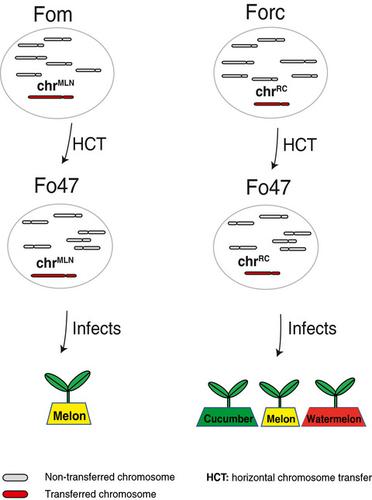当前位置:
X-MOL 学术
›
Mol. Plant Pathol.
›
论文详情
Our official English website, www.x-mol.net, welcomes your feedback! (Note: you will need to create a separate account there.)
Related mobile pathogenicity chromosomes in Fusarium oxysporum determine host range on cucurbits.
Molecular Plant Pathology ( IF 4.9 ) Pub Date : 2020-04-04 , DOI: 10.1111/mpp.12927 Jiming Li 1 , Like Fokkens 1 , Peter van Dam 2 , Martijn Rep 1
Molecular Plant Pathology ( IF 4.9 ) Pub Date : 2020-04-04 , DOI: 10.1111/mpp.12927 Jiming Li 1 , Like Fokkens 1 , Peter van Dam 2 , Martijn Rep 1
Affiliation

|
Fusarium oxysporum f. sp. radicis‐cucumerinum (Forc) causes severe root rot and wilt in several cucurbit species, including cucumber, melon, and watermelon. Previously, a pathogenicity chromosome, chrRC, was identified in Forc. Strains that were previously nonpathogenic could infect multiple cucurbit species after obtaining this chromosome via horizontal chromosome transfer (HCT). In contrast, F. oxysporum f. sp. melonis (Fom) can only cause disease on melon plants, even though Fom contains contigs that are largely syntenic with chrRC. The aim of this study was to identify the genetic basis underlying the difference in host range between Fom and Forc. First, colonization of different cucurbit species between Forc and Fom strains showed that although Fom did not reach the upper part of cucumber or watermelon plants, it did enter the root xylem. Second, to select candidate genomic regions associated with differences in host range, high‐quality genome assemblies of Fom001, Fom005, and Forc016 were compared. One of the Fom contigs that is largely syntenic and highly similar in sequence to chrRC contains the effector gene SIX6. After HCT of the SIX6‐containing chromosome from Fom strains to a nonpathogenic strain, the recipient (HCT) strains caused disease on melon plants, but not on cucumber or watermelon plants. These results provide strong evidence that the differences in host range between Fom and Forc are caused by differences between transferred chromosomes of Fom and chrRC, thus narrowing down the search for genes allowing or preventing infection of cucumber and watermelon to genes located on these chromosomes.
中文翻译:

尖孢镰刀菌的相关移动致病性染色体决定了葫芦科的寄主范围。
尖孢镰刀菌f。sp。radicis -黑星病菌(FORC)会引起严重的根腐病和枯萎在几个葫芦物种,包括黄瓜,甜瓜,西瓜和。以前,Forc中鉴定出了致病性染色体chr RC。通过水平染色体转移(HCT)获得此染色体后,以前无致病性的菌株可能感染多种葫芦科物种。相反,F.oxysporum f。sp。枯病(FOM)只能导致疾病的香瓜植物,即使FOM包含与CHR很大程度上同线重叠群RC。这项研究的目的是确定Fom和Forc之间宿主范围差异的遗传基础。首先,Forc和Fom菌株之间不同葫芦科物种的定殖表明,尽管Fom没有到达黄瓜或西瓜植物的上部,但它确实进入了根木质部。其次,为了选择与宿主范围差异相关的候选基因组区域,比较了Fom001,Fom005和Forc016的高质量基因组组件。与hr RC序列高度同序和高度相似的Fom重叠群之一含有效应基因SIX6。在SIX6的HCT之后包含从Fom菌株到非致病性菌株的染色体,受体(HCT)菌株在瓜类植物上引起疾病,但在黄瓜或西瓜植物上却不引起疾病。这些结果提供了有力的证据,表明Fom和Forc之间宿主范围的差异是由Fom和chr RC的转移染色体之间的差异引起的,从而缩小了寻找基因的搜索范围,从而允许或防止黄瓜和西瓜感染位于这些染色体上的基因。
更新日期:2020-04-04
中文翻译:

尖孢镰刀菌的相关移动致病性染色体决定了葫芦科的寄主范围。
尖孢镰刀菌f。sp。radicis -黑星病菌(FORC)会引起严重的根腐病和枯萎在几个葫芦物种,包括黄瓜,甜瓜,西瓜和。以前,Forc中鉴定出了致病性染色体chr RC。通过水平染色体转移(HCT)获得此染色体后,以前无致病性的菌株可能感染多种葫芦科物种。相反,F.oxysporum f。sp。枯病(FOM)只能导致疾病的香瓜植物,即使FOM包含与CHR很大程度上同线重叠群RC。这项研究的目的是确定Fom和Forc之间宿主范围差异的遗传基础。首先,Forc和Fom菌株之间不同葫芦科物种的定殖表明,尽管Fom没有到达黄瓜或西瓜植物的上部,但它确实进入了根木质部。其次,为了选择与宿主范围差异相关的候选基因组区域,比较了Fom001,Fom005和Forc016的高质量基因组组件。与hr RC序列高度同序和高度相似的Fom重叠群之一含有效应基因SIX6。在SIX6的HCT之后包含从Fom菌株到非致病性菌株的染色体,受体(HCT)菌株在瓜类植物上引起疾病,但在黄瓜或西瓜植物上却不引起疾病。这些结果提供了有力的证据,表明Fom和Forc之间宿主范围的差异是由Fom和chr RC的转移染色体之间的差异引起的,从而缩小了寻找基因的搜索范围,从而允许或防止黄瓜和西瓜感染位于这些染色体上的基因。



























 京公网安备 11010802027423号
京公网安备 11010802027423号